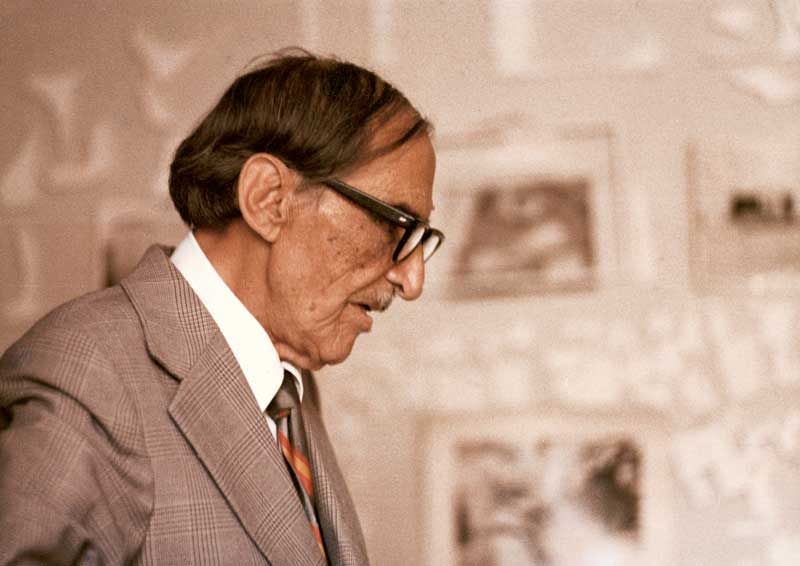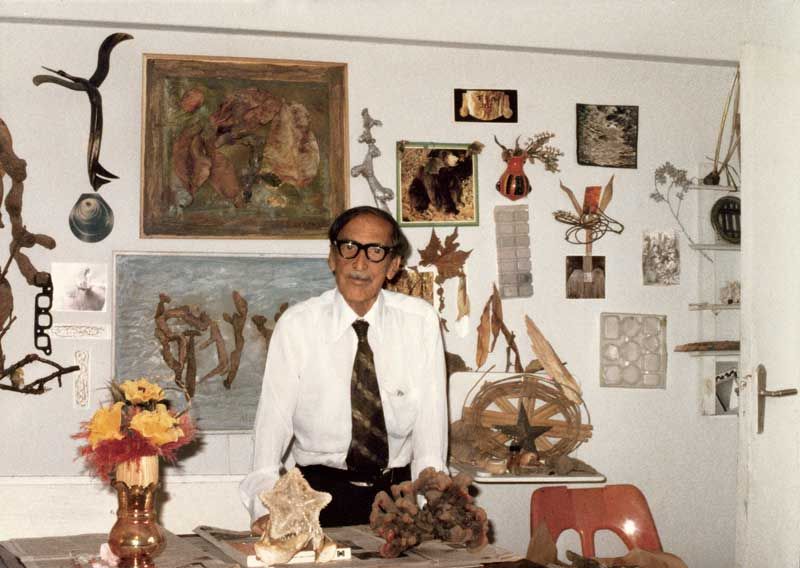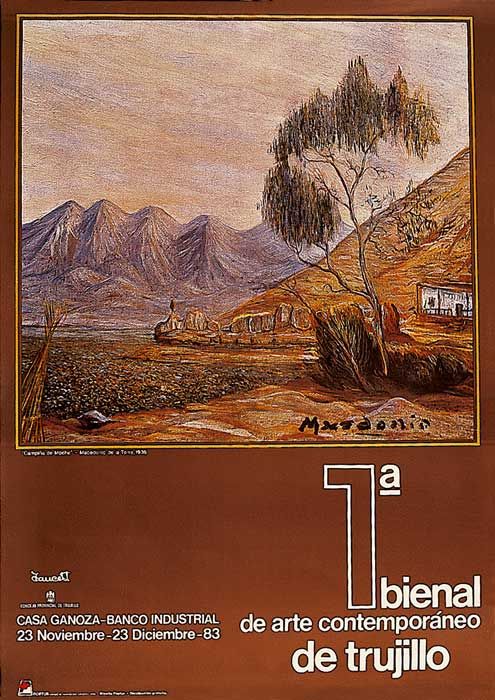
Macedonio meditating before one of his works.
One of the most picturesque anecdotes of the artist was related to us by Alfredo Arana: One day Macedonio asked my wife Blanca: “Blanca, is your home my home?” She enthusiastically answered yes and he proceeded to ask her if he could use the house for a cocktail for some friends. Of course, Blanca said yes. Macedonio prepared himself a cocktail and began to look for waiters. On the eve of the reception, the painter stood at the door, arms on his hips and legs spread apart, waiting for his guests. Some time later, five or six people arrived, amongst them Luis Alberto Sánchez and Felipe Cossío del Pomar. Macedonio remained outside until his guests, now bored, decided to leave. The following Monday, I met up with a local representative from Piura who had been invited to the gathering. When I asked him why he had not gone to the reception, I finally understood why the party had been a flop: Macedonio had told his guests that he would wait for them in front of my house, next to the gas station, to give them directions to the party. The problem was that this location was two blocks away on a different street! Of course, no one found him and all involved decided to call it a night!
“His imagination had no limits,” said Alfred. “I remember the day that we were climbing the steps of the building on Mogollón street where Macedonio had his studio. Macedonio was looking at some municipal postings on the walls that had deteriorated due to the climate and time. The posters´ original appearance had been altered, producing strange contrasts in shapes and colors. Next, he decided to enter a tailor’s shop to ask if he could borrow a chair and a pair of scissors. Instruments in hand, he proceeded to remove the poster from the wall and frame it. The result was truly artistic. “ With things like this who needs surrealism??”

Macedonio meditating before one of his works.
Arana continued, “Sometimes, Macedonio reminisced about his days in Paris with Vallejo. He became furious when he heard rumors about his friend. “What they are saying about César is untrue,” he exclaimed. “He was neither sad nor bitter. In fact, I recall how he liked to dress well. He was carefully groomed and well turned out; he refused to tolerate stains! He was also a very funny. He would repeat a song or poem that he liked over and over again, perhaps for a month or longer. Henriette was the love of Vallejo´s life. She was poor. When he married Georgette, things started to go better for him although he fought with her a lot.” Alfredo said that he had once asked Georgette about Vallejo and that she had replied: “Don´t ask me about him! He is already dead!” Gustavo Valcarcel explained the reasons behind this attitude on a visit we made to Georgette; apparently, she was very resentful towards Vallejo...
Macedonio frequented the “Zela” bar and the “Negro-Negro” at the Zela entrance of Plaza San Martín, and the café “Viena”, on Ocoña street, where he met up with fellow painters such as Ricardo Grau, Sérvulo Gutiérrez, Alberto Dávila, Fernando de Szyszlo, Sabino Springuett and Juan Manuel Ugarte Eléspuru. His favorite spot however was “café del Yugoslavo,” which was located on Jesus and Maria street (formerly Moquegua street) and situated in front of the Casa de Piedra, two hundred meters from Macedonio´s studio. This site was home to the National Association of Writers and Artists. (ANEA) Macedonio had many memorable conversations at ANEA, and in his later years he would stop here prior to entering a church from the viceroy period known as Nuestra Señora de las Mercedes to visit the cross of his venerable relative Father Pedro Urraca. On these visits, Macedonio would walk around the church’s sumptuous side altars. His attempts to connect with sacred objects led him to feel along the surface of each of these altars with his long hands, which were both nervous and expressive, as if this contact would establish some kind of communication with the energies of invisible and superior worlds.
Macedonio in his study in downtown Lima.

The colleagues with whom Macedonio met on these streets recalled the original and generous talent of the master from Trujillo. The painter Sabino Sringguett recounted one of the unexpected explanations so characteristic of Macedonio: “ One day, on a whim, I asked Macedonio how he painted exuberant vegetation on tiles and fabrics when he had never visited the jungle. He answered that he knew the jungle well because he owned the largest one of all. His conviction was disconcerting. To demonstrate the truth of this statement, Macedonio asked me to accompany him to his house. So I went. When we arrived, he took me to a patio that was full of different types of flowers and plants: “This is the jungle in my paintings! Everything I need is here!”
The memories of these picturesque episodes bring with them a collation of more diffused stories of Macedonio´s passion for landscape painting, which produced some of his best work. It is said that when the painter returned to Trujillo after his trip to Chile, Argentina and Bolivia, his relatives put him in charge of the hacienda “Las Quitanas” in Mansiche, located on the outskirts of Trujillo. On one opportunity, a farmer friend of Macedonio´s came to visit him and was surprised by the withered and deteriorated state of the fields at a time when these should have been in full growth. When he expressed his surprise to the painter, who had failed to order the help to water the fields on time, the painter replied, between brushstrokes on a canvass where he was painting the landscape: “Why are you worried about the harvest?” “Can’t you appreciate the beautiful tones of yellow that have appeared?”
Macedonio could be every gallery owner´s worst nightmare. On one occasion, Macedonio observed a spectator who was interested in one of his works. He walked over to the wall where the piece was hung, took it down and gave it to the admirer.
The painter often went to the extreme of offering to share the profits he had made from his recently sold paintings with friends he found along the way. He demonstrated this same generosity to his relatives, to whom he often gave his works as gifts. At every commentary Macedonio exclaimed soto voce: “Only he who has gives.”
During his tours about the city, Macedonio made frequent stops at locations that held something of interest for him. On his way to his son Víctor’s house, he would knock on painter Diego López-Aliaga´s door because he appreciated Diego´s work, particularly a “Nude in Blue” that Macedonio considered to be the finest of this artist´s work. López- Aliaga loved these moments and enjoyed the comments made by this slight, nervous and happy master who “lived off the smell of paint.”
During the last years of his life, Macedonio made frequent visits to his family and friends, including the Ganoza-Ashton, Benavides-Ganoza, Cárdenas-Martínez, Bolaños-Altamirano, Pérez-Romero Macchiavello, Tord Romero-Velasco Astete and Urquiaga-Gálvez families. These visits often included lively conversation about art, Macedonio´s renditions of classical music, card games and “sapo.” This last game was frequently played on visits to the Perez-Romero Macchiavello family, and stories tell how his friends managed to affect Macedonio´s concentration by playing on his superstitions. On one occasion, the painter´s opponents startled him by showing him a snake preserved in formaldehyde; in response, Macedonio made nervous and complicated gestures to counteract the snake’s malevolent influence!
Afiche de la Primera Bienal de Arte Contemporáneo de Trujillo en 1983 con reproducción del óleo de Macedonio de la Torre "Campiña de Moche".

As advisor on National Cultural Affairs to the President of the Republic, Architect Fernando Belaúnde Terry, I was witness to the President’s decision to distinguish Macedonio de la Torre with a medal for distinguished service, the Orden de Mérito por Servicios Distinguidos en el grado de Gran Cruz, given to our most distinguished painters, who, due to their trajectory and age, have been recognized by the Nation. The President personally delivered this distinction to Macedonio in 1981 while the artist was in a hospital bed in the Chorillos clinic, suffering from a terminal illness. That morning, the secretary to the President read the Supreme Resolution that bestowed the Order of the Great Cross in the presence of Macedonio´s wife, his children, grandchildren and relatives. The ceremony was a simple but highly emotional homage to a dying artist who eventually passed away a few months later at the age of 88. I gave the President the news of Macedonio´s passing moments after I had received the report; the date was May 13, 1981 and the location the “Grau” room of the Government Palace. The President’s aide, artists, writers and politicians attended the funeral service and the burial took place at the old cemetery “Presbítero Matías Maestro” in Lima. Currently, Macedonio´s body lies next to that of his lifelong love Adriana in the Jardines de la Paz cemetery, which is also located in Lima.
After our artist´s death, articles and death notices appeared in newspapers and magazines. These were a fitting testimony to the recognition and appreciation that this master enjoyed amongst Peruvians. Our painter was the last to pass away of the members of the intellectual youth movement from turn-of-the-century Trujillo and the group of Peruvian artists that frequented Paris in the 1920´s. At the time of his death, Macedonio was a doyenne of national painters.